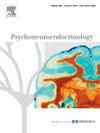去卵巢大鼠内侧前额叶皮层神经元TLR4过表达与神经炎症和抑郁样行为相关
IF 3.4
2区 医学
Q2 ENDOCRINOLOGY & METABOLISM
引用次数: 0
摘要
越来越多的证据表明toll样受体4 (TLR4)在抑郁症发病机制相关的神经炎症过程中的表达,但其在围绝经期抑郁症中的作用仍未被探索。本研究调查了卵巢切除术(OVX)后抑郁样行为背后tlr4相关炎症机制的并发变化,重点关注内侧前额叶皮层(mPFC)。蔗糖偏好和强迫游泳测试分别用于评估快感缺乏症和行为绝望。通过Western blotting定量分析mPFC中TLR4/MyD88/NF-κB/p65通路组分、促炎因子(TNF-α、IL-6、IL-1β)和凋亡标志物caspase-3,双免疫荧光染色绘制TLR4在神经元和小胶质细胞中的分布。OVX诱导抑郁样行为,同时TLR4-MyD88-NF-κB信号轴上调,促炎细胞因子水平升高,mPFC中caspase-3表达升高。双免疫荧光共定位分析显示,TLR4在神经元和小胶质细胞中均有表达,ovx后神经元选择性富集。值得注意的是,神经元TLR4表达谱显示凋亡标志物和细胞因子的平行变化。在OVX大鼠中,腹腔注射ibudilast(一种TLR4抑制剂)可显著改善抑郁样行为,减轻TLR4通路的上调,并降低神经炎症标志物。这些结果表明,OVX诱导神经元TLR4过表达,导致抑郁表型下并发的神经炎症和凋亡过程。这些发现支持TLR4抑制剂治疗围绝经期抑郁症的潜力,特别是通过靶向神经元特异性炎症级联反应。本文章由计算机程序翻译,如有差异,请以英文原文为准。
Neuronal TLR4 overexpression in the medial prefrontal cortex is associated with neuroinflammation and depression-like behaviors in ovariectomized rats
Growing evidence implicates Toll-like receptor 4 (TLR4) expression in neuroinflammatory processes linked to depression pathogenesis, yet its role in perimenopausal depression remains unexplored. This study investigated concurrent changes in TLR4-related inflammatory mechanisms underlying depression-like behaviors following ovariectomy (OVX), focusing on the medial prefrontal cortex (mPFC). Sucrose preference and forced swim tests were used to assess anhedonia and behavioral despair, respectively. Quantitative analysis of TLR4/MyD88/NF-κB/p65 pathway components, pro-inflammatory cytokines (TNF-α, IL-6, IL-1β), and apoptosis marker caspase-3 in the mPFC was conducted via Western blotting, whereas dual immunofluorescence staining mapped TLR4 distribution in neurons and microglia. OVX induced depression-like behaviors, along with upregulation of the TLR4-MyD88-NF-κB signalling axis, increased pro-inflammatory cytokines levels, and higher caspase-3 expression in the mPFC. Dual immunofluorescence colocalisation analysis revealed TLR4 expression in both neurons and microglia, with selective neuronal enrichment post-OVX. Notably, the neuronal TLR4 expression profiles showed parallel alterations in apoptosis markers and cytokines. Intraperitoneal administration of ibudilast, a TLR4 inhibitor, significantly ameliorated depression-like behaviors, attenuated upregulation of the TLR4 pathway, and reduced neuroinflammatory markers in OVX rats. These results demonstrate that OVX induces neuronal TLR4 overexpression, which results in concurrent neuroinflammatory and apoptotic processes underlying depressive phenotypes. These findings support the therapeutic potential of TLR4 inhibitors for perimenopausal depression, particularly by targeting neuron-specific inflammatory cascades.
求助全文
通过发布文献求助,成功后即可免费获取论文全文。
去求助
来源期刊

Psychoneuroendocrinology
医学-精神病学
CiteScore
7.40
自引率
8.10%
发文量
268
审稿时长
66 days
期刊介绍:
Psychoneuroendocrinology publishes papers dealing with the interrelated disciplines of psychology, neurobiology, endocrinology, immunology, neurology, and psychiatry, with an emphasis on multidisciplinary studies aiming at integrating these disciplines in terms of either basic research or clinical implications. One of the main goals is to understand how a variety of psychobiological factors interact in the expression of the stress response as it relates to the development and/or maintenance of neuropsychiatric illnesses.
 求助内容:
求助内容: 应助结果提醒方式:
应助结果提醒方式:


